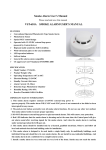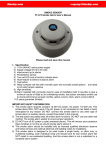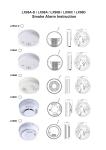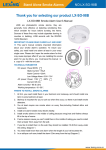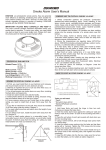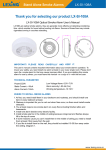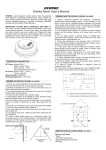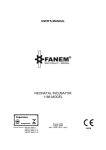Download DSW218A-D Smoke Alarm User's Manual
Transcript
DSW218A-D Smoke Alarm User’s Manual PLEASE READ AND SAVE THIS MANUAL SPECIFICATION IMPORTANT SMOKE ALARM PLACEMZNT AND EXCEPTION INFORMATION Power supplied DC9V battery and back-up source 110V-240V AC mains power supply Supply voltage DC12 to 30 volts Rechargeable battery and lithium 10 year 9 volt batteries Interconnect up to alarms Photoelectric sensor Red LED indicate alarm Green LED mains indicator light to confirm mains power supply Unique “battery missing” lockout Hush feature to silence nuisance alarms Test button Low battery alarm Relay contacts-volt free with Normally Open and Normally Closed options and rated to 24 volts/lamp resistive High sensitivity Alarm supplied with "connector plug" for ease of installation Built in sounder to give a minimum sound output of 85dB at 3m Senses smoke using the light scatter principlequick response to visible smouldering smoke, test button simulates smoke - use to check performance at least monthly, option current 10uA, alarm current 30mA. 5 year guarantee (limited) 1. Install a smoke alarm as close to the center of the ceiling as possible. If this is nopractical, mount no closer than 4 inches from a wall or corner. Also, if local codesallow, install smoke alarms on walls, between 4 and 12 inches from ceiling/wall intersections. 2. Install a minimum of two smoke alarms in every home, no matter how small the home. New construction codes require a minimum of two interconnected smoke alarms in newlly built homes. 3. Install a smoke alarm in each room that is divided by a partial wall (either coming down from then ceiling at least 8 inches, or coming up from the floor). 4. Install a smoke alarm in lived-in attics which house electrical equipment like furnaces, air conditioners, or heaters. IMPORTANT SAFETY INFORMATION 1. This smoke alarm requires constant 12-30V DC power, AC power 110-240 volt AND DC 9-volt battery to operate properly. This smoke alarm WILL NOT work if AC power is not connected or has failed or been interrupted for any reason AND the battery is removed, drained or improperly connected. DO NOT use any other kind of battery except as specified in this manual. DO NOT connect this smoke alarm to any other type of smoke alarm or auxiliary device, except those listed in this manual. 2. The test button accurately tests all smoke alarm functions. Do not use any other test method. Test smoke alarm weekly to ensure proper operation. 3. DO NOT remover nr disconnect battery or turn off AC power to quiet unwanted alarms. This will remove your protection. Open windows or fan the air around smoke alarm silence it. 4. This smoke alarm should be installed only by a licensed, qualified electrician Observe and follow all local and national electrical and building codes for installation. 5. This smoke alarm is designed to be used inside a single family only. In multifamily buildings, each individual living unit should have its own smoke alarms. Do not install in non-residential buildings. And this smoke alarm is not a substitute for a complete alarm system. 6. Install a smoke alarm in every room and on every level of the home. Smoke may not reach the smoke alarm for many reasons. For example, if a fire starts in a remote part of the home, on another level, in a chimney, wall, roof, or on the other side of a closed door, smoke may not reach the smoke alarm in time to alert household members. A smoke alarm will not promptly detect a fire except in the area or room in which it is installed. 7. Smoke alarms may not alert every household member every time. The alarm horn is loud in order to alert individuals to a potential danger. However, there may be limiting circumstances where a household member may not hear the alarm (i.e. outdoor or indoor noise, sound sleepers, drug or alcohol usage, the hard of hearing, etc.). If you suspect that this smoke alarm may not alert a household member, install and maintain specialty smoke alarms. Household member must hear the alarm’s warning sound and quickly respond to it to reduce the risk of damage, injury, or death that may result from fire. If a household member is hard of hearing, install special smoke alams with lights or vibrating devices to alert occupants. 8. Smoke alarms can only sound their alarms when they detect smoke. Smoke alarms detect combustion particles in the air. They do not sense heat, flame, or gas. This smoke alarm is designed to give audible warning of a developing fire. However, many fires are fast-burning, explosive, or intentional. Others are caused by carelessness or safety hazards. Smoke may not reach the smoke alarm QUICKLY ENOUGH to ensure safe escape. 9. Smoke alarms have Iimitations. This smoke alarm is not foolproof and is not warranted to protect lives or property from fire. Smoke alarms are not a substitute for insurance. Homeowners and renters should insure their lives and property. In addition, it is possible for the smoke alarm to fail at ,any time. For this reason, you must test the smoke alarm weekly and replace every 5 years. FOR BEST PROTECTION, WE RECOMMEND THAT YOU INSTALL A SMOKE ALARM IN EVERY ROOM Typical single storey dwelling with recommended protection (see figure 1), interconnect series (see figure 3). Install a smoke alarm on the ceiling of wall inside each bedroom and in the hallway outside each separate sleeping area. If a bedroom area hallway is more than 30 feet long, install a smoke alarm at each end. If there is a basement: Install a smoke alarm on the basement ceiling at the bottom of the stairwell. Typical multi storey dwelling with recommended protection (see figure 2) Install a smoke alarm on the ceiling of wall inside each bedroom and in the hallway outside each separate sleeping area. If a bedroom area hallway is moire than 30 feet long, install a smoke alarm at each end install a smoke alarm at the top of a first-to-second floor stairwell. Bedroom Bedroom BEDROOM LIVING ROOM HALL BEDROOM BEDROOM KITCHEN RED ROOM Bedroom BATH Living Room BASEMENT BASEMENT KITCHEN Hall FURNACE ROOM Hall Kitchen Basemenl Utility Room TWO STORY RESIDENCE DO NOT INSTALL SMOKE ALARMS 1. Near appliances or areas where normal combustion regularly occurs (kitchens, near furnaces, hot water heaters). Use specialized smokealarm with unwanted alarm control for this areas. 2. In areas with high humidity, like bathrooms or areas near dishwashers or washing machines. Install at least 10 feet away from these areas. 3. Near air returns or heating and cooling supply vents. Install at least 3 feeaway from these areas. The air could blow smoke away from the detector, interrupting its alarm. o o 4. In rooms where temperatures may fall below 40 F or rise above 100 F. 5. In extremely dusty, dirty or insect-infested areas loose particles interfere with smoke alarm operation. DANGER: Turn off power at the main fuse box or circuit breaker by removing the fuse or switching the circuit breaker to the off position. HOW TO INSTALL THIS SMOKE ALARM (DSW218A-D series, see figure 4/5 and 4.5) WARNING: This smoke alarm should be installed only by a qualified electrician. Smoke alarm installation must be in accordance with the requirements or Article 760 of the national electrical code and any local codes that may apply. From back of smoke alarm, turn mounting plate counterclockwise to remove mounting plate. (To later engage tamper-resist feature, twist, out and et aside one of the pins molded into plate. Both pins are exactly the same.) 1. OPEN THE COVER OF SMOKE ALAR FIRST INSTALL THE SMOKE ALARM ON THE CEILING, AND SCREW UP. (DSW218A-D, see figure 6) BLACK BLACK 4 IN (0.1m) CEILING ACCEPTABLE HERE INTERCONNECT WIRE CONNECTOR YELLOW (ORANGE ON MODEL FXW-R) WHITE 4 IN (0.1m) MINIMUM NEVER HERE 12 IN (0.3m) MAXIMUM TOP OF DETECTOR ACCEPTABLE HERE SIDE WALL 2. Gently pull household wires through center hole of plate. 3. Secure plate to ceiling or wall with mounting screws. 4. With a small wire connector, connect white wire from connecter plug to white household wire. 5. If interconnection is desired, connect yellow wire from connector to interconnect wire between smoke alarms. See section interconnecting smoke alarms. NOTE: If this will be a single-station smoke alarm, cover yellow wire with electrical tape and tuck into junction box. 6. Lift open battery pocket door. 7. Connect new 9-volt battery to batter connector inside battery pocket. Be sure battery is securely connected. Smoke alarm may beep briefly when battery is installed. 8. Close battery pocket door, snapping it into place. 9. Attach connector plug to pins on back of smoke alarm. Plug will only fit one way and will snap into place. 10. Gently tug connector to be sure it is attached securely. 11. Position smoke alarm to mounting plate and turn clockwise to lock into place. To engage tamper-resist feature, insert pin into notch on edge of smoke alarm after alarm is properly positioned in base. NOTE: Smoke alarm will not mount to plate if battery is not installed. Y TER BAT 12. Turn on power at main fuse box or circuit breaker. 13. Push test button to test smoke alarm. See testing the moke alarm. For interconnect line only use #14-#18 AWG minimum solid or stranded wire. When interconnecting, maximum wire length between any two is 1500 feet for #18 AWG or 4000 feet for #14 AWG (20 OHMS loop resistance). INTERCONNECTING SMOKE ALARMS (DSW218A/DSW318A series see figure 7, DSW218B series see figure 8) This smoke alarm may be interconnected with as many as 11 other fires model AD and ADC smoke alarms. Do not connect to any other type or model smoke alarm. Connect smoke alarms to a single AC branch circuit. If local codes do not permit, he sure the neutral wire is common to both phases. 6. Remove battery from pocket. Disconnect and discard battery from battery connector. 7. Connect a fresh 9-volt battery to connector. The battery will fit only one way. Be sure battery connector is securely attached to battery into battery terminals. 8. Place battery into battery pocket. 9. Close battery pocket door. Push down until it snaps into place. 10. Replace connector plug. Connector will snap into place. 11. Reattach smoke alarm to mounting plate by turning smoke alarm clockwise until it snaps into plate. 12. Turn on power and test smoke alarm using push-to-test button. CLEANING WHITE WHITE YELLOW YELLOW BLACK BLACK WHITE BLACK TO NEUTRAL TO 120 VAC (HOT) Clean the smoke alarm at least once a month to remove dust, dirt, or debris. Always turn off power to smoke alarm before cleaning. Using the soft brush or wand attachment to a vacuum cleaner, vacuum all sides and cover of smoke alarm. Be sure all the vents are free of debris. If necessary, turn off power and use a damp cloth to clean smoke alarm cover. IMPORTANT: Do not attempt to remove the cover of clean inside the smoke alarm. This will avoid warranty. REPAIR INTERCONNECT COMPATIBLE 24 VOLT PANEL NORMALLY OPEN CIRCUIT COMMON NORMALLY OPEN COMMON NORMALLY OPEN NORMALLY CLOSED NORMALLY CLOSED INTERCONNECT - INTERCONNECT - + + PRACTICE FIRE SAFETY GND +24V (a) CIRCUIT FOR NORMALLY OPEN RELAY CONTACTS COMPATIBLE 24 VOLT PANEL NORMALLY OPEN CIRCUIT INTERCONNECT If the smoke alarm sounds its alarm horn, and you have not pushed the test button, it is warning of a dangerous situation. Your immediate response is necessary. To prepare for such occurrences, develop family escape plans, discuss them with all household members, and practice them regularly. 1. Expose everyone to the sound of a smoke alarm and explain what the sound means. 2. Determine two exits from each room and an escape route to the outside from each exit. 3. Teach all household members to touch the door and use an alternate exit it the door is hot. Instruct them not to open the door if the door is hot. 4. Teach household members to crawl along the floor to stay below dangerous smoke, fumes and gases. 5. Determine a safe meeting place for all members outside the building. COMMON NORMALLY OPEN COMMON NORMALLY OPEN NORMALLY CLOSED NORMALLY CLOSED WHAT TO DO IN CASE OF FIRE INTERCONNECT - INTERCONNECT - + + 1. Do not be panic; stay calm. 2. Leave the building as quickly as possible. Touch doors to feel if they are hot before opening them. Use an alternate exit if necessary. Crawl along the floor, and do not stop to collect anything. 3. Meet at a pre-arranged meeting place outside the building. 4. Call the fire department from outside the building. 5. Do not go back inside a burning building. Wait for the fire department to arrive. These guidelines will assist you in the event of a fire. However, to reduce the chance that fires will start, practice fire safety rules and prevent hazardous situations. EOL DEVICE GND +24V Caution: Do not attempt to repair this smoke alarm. Doing this will avoid your warranty. If smoke alarm is not operating property, and is still under warranty, return smoke alarm to our company. Pack it in a well-padded carton, shipping prepaid, to. Ningbo DSW Electronics Co., Ltd. Address: Room1121 Linqiao Piazza, Ningbo City,315010, China If the smoke alarm is no longer under warranty, have a licensed electrician replace the smoke alarm immediately with a comparable Dongji brand smoke alarm. EOL = END OF LINE DEVICE, SPECIFIED BY PANEL TESTING THE SMOKE ALARM (see figure 9) 1. Test each smoke alarm to be sure it is installed correctly and opera ring property. 2. Test all smoke alarms in an interconnected system after installation. 3. The push-to-test button accurately tests functions. Do not use an open flame to test this smoke alarm. You may ignite and damage the smoke alarm or your home. 4. Test smoke alarms weekly and upon returning from vacation or when no one has been in the household for several days. 5. Stand at arm’s length from the smoke alarm when testing. Test all smoke alarms weekly by doing the following: 1). Observe the green LED. A constant green light indicates the smoke alarm is receiving 110V-240V AC power. (DSW218A-D) 2). Firmly depress the push-to-test button for at least 5 seconds. The smoke alarm will sound 3 short beeps followed by a 2-second pause and then repeats. The alarm may sound for up to 10 seconds after releasing the push-to-test button. NOTE: If smoke alarms are interconnected, all smoke alarms should sound an alarm within three seconds after any test button is pushed and the tested smoke alarm sounds. 3). If smoke alarm does not sound, turn off power at main fuse box or circuit breaker and check wiring. Retest smoke alarm. DANGER: If alarm horn sounds, and smoke alarm is not being tested, the smoke alarm is sensing smoke. THE SOUND OF THE ALARM HORN REQUIRES YOUR IMMEDDIATE ATTENTION AND ACTION. MAINTENANCE AND CLEANING In addition to weekly testing, this smoke alarm requires yearly battery replacement and periodic cleaning to remove dust, dirt, and debris. Danger: electrical shock hazard. Turn off power at main service panel by removing fuse or switching appropriate circuit breaker to off position before replacing battery or cleaning smoke alarm. (DSW218A-D series) BATTETY REPLASCEMENT (DSW218A-D: see figure 11) DSW218A-DS SERIES: Always turn off power to smoke alarm before replacing battery. Replace battery at least once a year or immediately when the low battery signal sounds once a minute, even though the smoke alarm is receiving AC power, Batteries should be replaced regularly as necessary, even when the smoke alarm is receiving AC power. Use rechargeable batteries must 5 years replace. Warning: Do not use any other type of battery, except as specified in this manual. Do not use rechargeable batteries. Use these batteries to replace the old one. Carbon zinc: EVEREADY 216 OR 2122; GOLDPEAK 1604P OR 1604S Alkaline: EVEREADY 522; DURACELL MNI604 MS1604; GOLDPEAK 1604A Lithium: ULTRALIFE U9VL You’d batter use good battery to make the alarm work long, some batteries can use more than 1year. 1. Turn off power to smoke alarm at main service panel. (DSW218A:OPEN THE COVER OF SMOKE ALARM FIRST) see figure 6. 2. Turn smoke alarm counterclockwise to detach from mounting plate. 3. Gently pull down smoke alarm. Be careful not to separate wire connections. 4. Pull out power plug from back of smoke alarm. 5. From back of smoke alarm, lift tab to open battery pocket door. TROUBLESHOOTING DANGER: Always turn off power at main fuse box or circuit breaker before taking troubleshooting action. WARNING: Do not disconnect battery or AC power to quiet an unwanted alarm. This will remove your protection. Fan the air or open a window to remove smoke or dust. PROBLEM Smoke alarm does not sound when tested. NOTE: Push test button for at least five seconds while testing! 1.Check that AC power is turned on. 2.Turn off power. Remove smoke alarm from mounting plate and: a Check that connector plug is securely attached. b Check that battery is properly at tached to connector. 3. Clean smoke alarm. Smoke alarm beeps about once a minute. Turn off power and replace battery. See battery replacement in the maintenance and cleaning section. Smoke alarm sounds unwanted alarms intermittently or when residents are cooking, taking showers, etc. 1. Clean smoke alarm. See cleaning in the maintenance and cleaning section 2 Hire an electrician to move smoke alarm to a new location. See smoke alarm placement Interconnected smoke alarms do not sound when system is tested Press and hold test button for at least three seconds after the first unit sounds. The alarm sounds different than I’m used to. It starts and stops. The alarm is operating correctly. This alarm features the internationally recognized horn signal for evacuation. The horn pattern is 3 short beeps followed by a 2 second pause and then Repeats.




